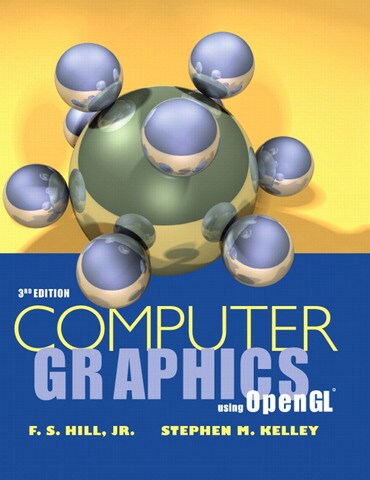
Computer Graphics Using OpenGL, 3rd edition
Title overview
For undergraduate Computer Graphics courses.
Updated throughout for the latest developments and technologies, this text combines the principles and major techniques in computer graphics with state-of-the-art examples that relate to things students see everyday on the Internet and in computer-generated movies. Practical, accessible, and integrated in approach, it carefully presents each concept, explains the underlying mathematics, shows how to translate the math into program code, and displays the result.
-
C++ as the underlying programming language –Introduces useful classes for graphics, but does not force a rigid object-oriented posture.
-
Early, in-depth treatment of 3D graphics and the underlying mathematics – Enables students to produce realistic 3D graphics much earlier in a course. Students can write programs to “fly” a camera through a 3D scene.
-
Extensive case studies at the end of each chapter.
-
Clear flow of ideas from first principles to the techniques of graphics:
-
Clear presentation of the links between a concept, underlying mathematics, program coding, and the result – e.g., the use of vectors in graphics, the underlying theory of transformations, the mathematics of perspective projections, etc.
-
An abundance of state-of-the-art worked examples.
-
Numerous practice exercises (approx. 30 per chapter).
• Updated treatment of graphics hardware and algorithms.
• More emphasis on interactive graphics – Includes menu design and interaction, and the use of OpenGL to simplify real-time interactions such as flying a camera through a scene.
• Discussion of the development of video games through history.
• Discussions on the graphics pipeline – Includes coverage of the latest versions OpenGL & the Shading Language and the benefits they provide.
• Reduced emphasis on PostScript, Hidden Surface Removal, Relative Drawing, and Fractals. These topics are still covered but have been moved to appendices.
• Full working source code provided for all significant examples, either in the book or on the book’s companion website.
• Significant improvements to organization, based on second edition user feedback and reviewer comments.
• Larger number of problems than the previous edition.
• Case studies revised throughout – Increased in number and refined throughout; they correspond more closely to the topics in each chapter.
Table of contents
-
Chapter 1 Introduction to Computer Graphics
-
Chapter 2 Getting Started Drawing Figures
- Chapter 3 Additional Drawing Tools
- Chapter 4 Vector Tools for Graphics
- Chapter 5 Transformations of Objects
- Chapter 6 Modeling Shapes with Polygonal Meshes.
- Chapter 7 Three-Dimensional Viewing
- Chapter 8 Rendering Faces for Visual Realism
- Chapter 9 Tools for Raster Displays
- Chapter 10 Curve and Surface Design
- Chapter 11 Color Theory
- Chapter 12 Ray Tracing
-
References
-
Index
Author bios
F.S. Hill Jr. is a Professor Emeritus of the Electrical and Computer Engineering Department at the University of Massachusetts at Amherst. He received a Ph. D. degree from Yale University in 1968, worked for 3 years in digital data transmission at Bell Telephone Laboratories, and joined the University in 1970. He is the author of numerous articles in the field of signal processing, communications, and computer graphics. He has been editor and associate editor of the IEEE Communications Society magazine. He is also a fellow of the IEEE. He is co-author of the book Introduction To Engineering and has won several awards for outstanding teaching.
Stephen M. Kelley and Dr. Hill met in 2000 in connection with a National Science Foundation distance learning project. Since then co-teaching courses in computer graphics at the University of Massachusetts and co-authoring Computer Graphics using OpenGL, 3rd Edition. Stephen Kelley recently graduated from the University of Massachusetts with a degree in Interactive Multimedia and Computer Graphics along with a minor in Information Technology. Stephen also runs his own web development and consulting company, Intangible Inc.